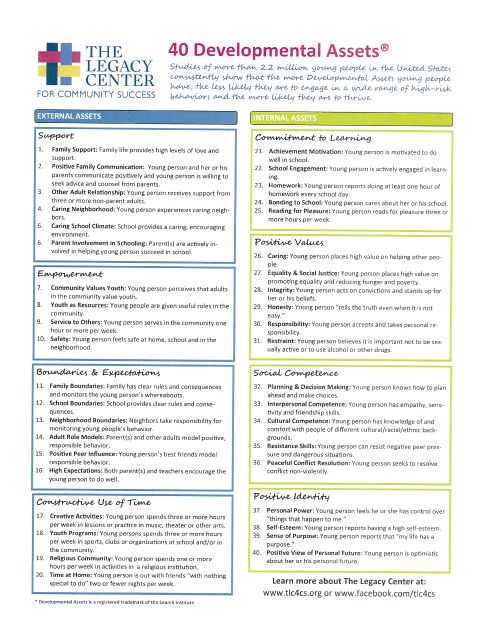Building assets for youth success
Youth need assets to avoid risky behavior and become successful adults.

As parents, it is easy to get scared watching the news and seeing crime, drinking and driving, teen pregnancy, drugs and suicide. You might be wondering, “How can I prevent these things from happening to my children or the youth in my community?” We all know there is no secret pill for perfect parenting, but according to the Search Institute, there are ways parents and communities can help youth develop positive assets to become successful adults.
Created in the 1990’s, the framework of the 40 Developmental Assets ® is grounded in research on child and adolescent development, risk prevention and resiliency. Search Institute’s research shows that the more assets young people have, the less likely they are to engage in risky behaviors. In addition, these common themes about the importance of assets have emerged from numerous findings:
- Assets promote academic success.
- Assets divert youth from risky behaviors and increase civic engagement.
- Assets give young people the strengths they need to make positive choices in life.
- Assets make a difference.
Eight types of assets have been identified as crucial for helping young people grow up healthy.
- Supporting and loving your child. Show courtesy to youth, invite caring and responsible adults into child lives, while also encouraging passions and interests.
- Empowering your child, Get youth involved in events, encourage teens to take leadership roles, do community service together and teach youth how to be safe.
- Setting clear and realistic boundaries and expectations. Talk about family rules and consequences, treat all people with respect, respect teen privacy, but show interest in their friends and activities.
- Helping your child use their time in meaningful, constructive ways. Help youth find hobbies, visit libraries, museums, concerts, have regularly family night to do something fun, and involve youth in decisions about spiritual activities and volunteering.
- Encouraging your child to develop a commitment to learning. Have youth teach you a new skill, set goals daily, read books, invite friends for dinner and believe all youth can learn.
- Instilling in your child positive values. Show care and concern with others by offering a helping hand, mistakes are part of living and growing, and help youth write down what they believe. Be responsible for all words and actions, try new things and take on new responsibilities.
- Developing social competencies in your child. Have family meetings with youth voice and decision making, learn about your culture, smile and say hello to a new person each day.
- Encouraging your child to form a positive identity. Build up positive behavior, avoid comparing youth, listen to teen’s talk about sense of purpose, and ask their passions.
To learn about all 40 Development Assets, ® visit the Search Institute website.
Together as parents and youth in our communities, we can strive to develop the positive assets that will help youth be successful in life. Through Michigan State University Extension’s Michigan 4-H Youth Development program, youth are building assets through positive relationships with leaders, empowering youth to be creators of their own development and helping others through service. Building assets fits into the 4-H Thriving Model, which is a theory of change for positive youth development in 4-H and gives us the tools to help youth thrive.
For additional information about youth thriving and how you can be a champion for youth, visit these articles by other MSU Extension staff.



 Print
Print Email
Email




